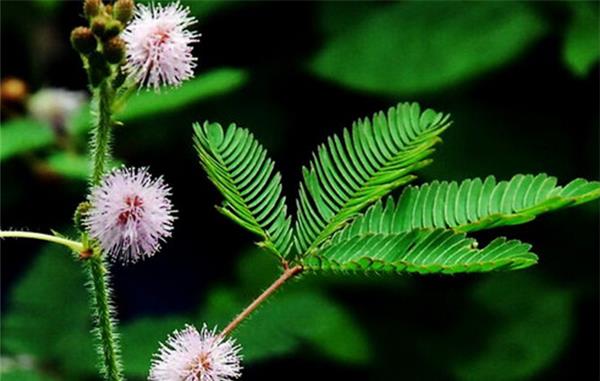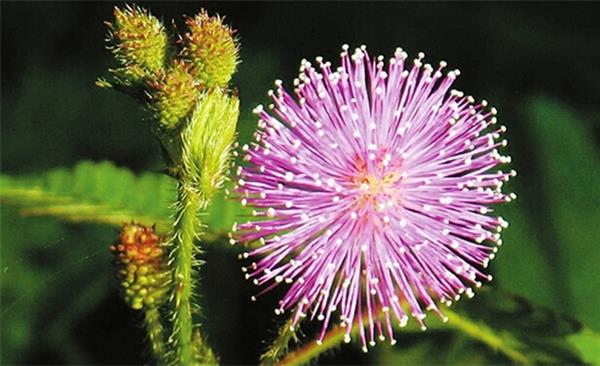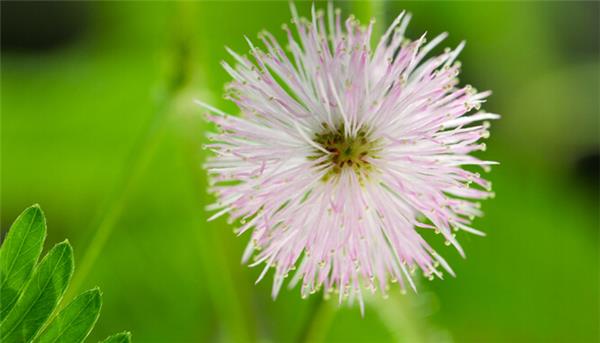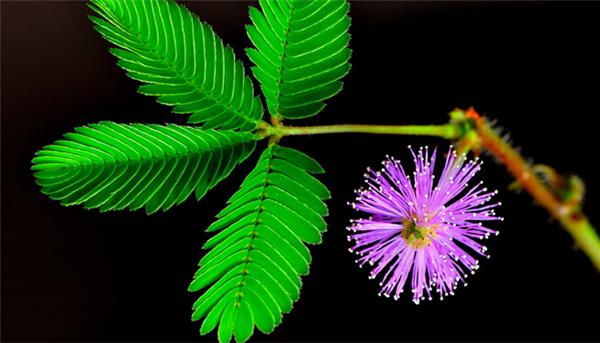Explain whether mimosa is poisonous and the reason why mimosa is shy.
For the question of whether mimosa is poisonous, let's first take a look at the basic introduction of mimosa. Mimosa is also known as Mimosa, Mimosa, and fear of ugliness. It is a perennial herb of Leguminosae. The country of origin is tropical South America, and it likes to grow in warm and humid places, but there is no higher requirement for the fertility of the soil, so it is easy to survive. Its flowers are pink, shaped like fluffy balls, and are very lovely. It will bear fruit after flowering, and the fruit is flat and round. Mimosa is suitable for balcony and indoor as a potted plant. So, everyone will ask, is mimosa poisonous?

Is mimosa poisonous?
poisonous.
Shy prairie is produced in tropical South America, like warm and humid, loose requirements on the soil, like light, but can withstand semi-shade, so it can be used for indoor potted flowers. The mimosa leaflet is small, pinnately arranged, and touches the leaflet with the hand. After the lobule is stimulated, it will close. If the shock is strong, the stimulus can be transmitted to the whole leaf, then the total petiole will droop, and even it can be passed to the adjacent leaves to make its petiole droop, as if a girl is shy and drooping powder. But the shy and lovely mimosa is actually poisonous, so we must not underestimate it.
Mimosa contains a substance called mimosa, which is harmful to the human body. if you come into contact with mimosa frequently, it will lead to numb eyebrows, yellow hair and even hair loss. Mimosa is generally not toxic to the human body during the day, but at night, because it cannot carry out photosynthesis, it will release toxic substances. In other words, mimosa is actually poisonous.
Mimosa has a small poison in the whole plant, but it does not have much effect on people. The whole plant of mimosa has a small poison, but it does not have much effect on human beings. The whole plant of mimosa is used in medicine to calm the mind, stop bleeding and relieve pain.

So mimosa had better not be taken. Do not have long-term contact with it, short-term contact, as long as you do not eat poison is not big.
In nature, there is a recommendation called mimosa. If you gently touch the mimosa, its open feathery leaves will immediately close, and then the whole leaf will hang down again, showing a very "shy" look. Do you know why mimosa is shy?
Why is the mimosa shy?
In fact, the phenomenon that mimosa folds up its petiole and lowers its head is not because of shyness, but a response of plants to stimulation and vibration. This response, known as perceptual movement in biology, is the result of changes in cell tension when mimosa is stimulated by external stimuli.
The hometown of mimosa is in Brazil in tropical South America, where there are often strong winds and heavy rain. Whenever the first drop of rain hits the leaves, it immediately closes the leaves and the petiole droops to reduce the damage caused by the storm. This is a way for it to adapt to the changes of external environmental conditions. In addition, this reaction of mimosa can also be seen as a way of self-defense. When an animal touches it, it closes its leaves, and animals dare not eat it any more.
The reason why mimosa is shy is closely related to its native environment. The shy prairie comes from tropical South America, where the climate is bad and there are often high winds and torrential rains. In order to protect itself, when the first drop of Rain Water falls on the mimosa leaf, it will close the leaf promptly and effectively and hang its petiole to avoid the damage of the storm, which is the self-adjustment of the biological world.

At the base of the petiole and at the base of the leaflet of the compound leaf, there is a relatively inflated part called the leaf pillow. When the vibration reaches the leaf pillow, the cell fluid from the parenchyma cells in the upper half of the leaf pillow is discharged into the intercellular space, which reduces the turgor pressure of the cells in the upper part of the leaf pillow, while the parenchyma cell space in the lower part still maintains the original turgor pressure. as a result, the leaflets stand upright, the two leaflets close, and even the whole leaf hangs down.
It has been studied that within 0.088 seconds after being stimulated, the mimosa leaves will close, and after a while, the small leaves will reopen and the petiole will stand up. The recovery time is usually 5-10 minutes. However, if we continue to tease and stimulate its leaves one after another, it will feel "bored" and will no longer react. This is because the continuous stimulation causes the loss of the cell fluid which controls the opening and closing of the leaf occipital cells and can not be replenished in time. Isn't that interesting? Mimosa plant type is beautiful, giving people a kind of lovely feeling, very suitable for home decoration, what is the role of mimosa?
The function of mimosa: 1. Ornamental
Mimosa plant shape scattered, feather leaves slender and beautiful, its leaves are closed at a touch; mimosa flowers are many and beautiful, charming, giving people the impression of weak and elegant. It can be planted in the corner of the courtyard or potted in the window. When giving flowers, gently cover the potted plants with pink tulle and tie them with pink ribbons and knots. It would be more interesting if you could adorn it with pink mohair balls.

The function of mimosa: 2. Forecast the weather
Mimosa is a wonderful plant that can predict changes in the weather. If you touch it with your hand, its leaves close quickly and open slowly, indicating that the weather will clear up; if you touch mimosa, its leaves contract slowly, droop slowly, or even reopen a little bit, this means that the weather will change from sunny to overcast or it is going to rain.
The function of mimosa: 3. Earthquake prediction
According to Turkish seismologist Erjiang, a few hours before a strong earthquake, the leaves of mimosa, which are sensitive to the outside world, suddenly shrink and then wither. In earthquake-prone Japan, scientists have found that under normal circumstances, mimosa leaves open during the day and close at night. If the leaves of mimosa close during the day and open at night, it is a sign of an earthquake.
The function of mimosa: 4. Medicinal use
It has the effects of clearing heat and diuresis, resolving phlegm and relieving cough, calming nerves and relieving pain, detoxification, removing blood stasis, hemostasis, convergence and so on. For colds, children with high fever, acute conjunctivitis, bronchitis, gastritis, enteritis, urinary calculi, malaria, neurasthenia; external treatment of swelling and pain, sores, hemoptysis, herpes zoster.

Mimosa has ornamental and medicinal functions, and it also has the unique role of weather prediction and earthquake prediction. Those who like mimosa might as well raise several pots and decorate them at home. The above is the information about whether mimosa is poisonous or not and other information about mimosa, which I hope can be explained to you.
It can be planted in the corner of the courtyard or potted in the window. When giving flowers, gently cover the potted plants with pink tulle and tie them with pink ribbons and knots. It would be more interesting if you could adorn it with pink mohair balls.

The function of mimosa: 2. Forecast the weather
Mimosa is a wonderful plant that can predict changes in the weather. If you touch it with your hand, its leaves close quickly and open slowly, indicating that the weather will clear up; if you touch mimosa, its leaves contract slowly, droop slowly, or even reopen a little bit, this means that the weather will change from sunny to overcast or it is going to rain.
The function of mimosa: 3. Earthquake prediction
According to Turkish seismologist Erjiang, a few hours before a strong earthquake, the leaves of mimosa, which are sensitive to the outside world, suddenly shrink and then wither. In earthquake-prone Japan, scientists have found that under normal circumstances, mimosa leaves open during the day and close at night. If the leaves of mimosa close during the day and open at night, it is a sign of an earthquake.
The function of mimosa: 4. Medicinal use
It has the effects of clearing heat and diuresis, resolving phlegm and relieving cough, calming nerves and relieving pain, detoxification, removing blood stasis, hemostasis, convergence and so on. For colds, children with high fever, acute conjunctivitis, bronchitis, gastritis, enteritis, urinary calculi, malaria, neurasthenia; external treatment of swelling and pain, sores, hemoptysis, herpes zoster.

Mimosa has ornamental and medicinal functions, and it also has the unique role of weather prediction and earthquake prediction. Those who like mimosa might as well raise several pots and decorate them at home. The above is the information about whether mimosa is poisonous or not and other information about mimosa, which I hope can be explained to you.
- Prev

Reveal the production steps of red maple bonsai how to raise red maple bonsai well
Reveal the production steps of red maple bonsai how to raise red maple bonsai well
- Next

Step-by-step Analysis of the planting techniques of potted Honeysuckle and the function of Honeysuckle
Step-by-step Analysis of the planting techniques of potted Honeysuckle and the function of Honeysuckle
Related
- Wuhan Hospital Iron Tree Blooming Result Was Instantly Frightened by the Gardener Master
- Which variety of camellia is the most fragrant and best? Which one do you like best?
- What is the small blue coat, the breeding methods and matters needing attention of the succulent plant
- Dormancy time and maintenance management of succulent plants during dormancy
- Minas succulent how to raise, Minas succulent plant pictures
- What are the varieties of winter succulent plants
- How to raise succulent plants in twelve rolls? let's take a look at some experience of breeding twelve rolls.
- Attention should be paid to water control for succulent plants during dormant period (winter and summer)
- Watering experience of twelve rolls of succulent plants
- Techniques for fertilizing succulent plants. An article will let you know how to fertilize succulent plants.

